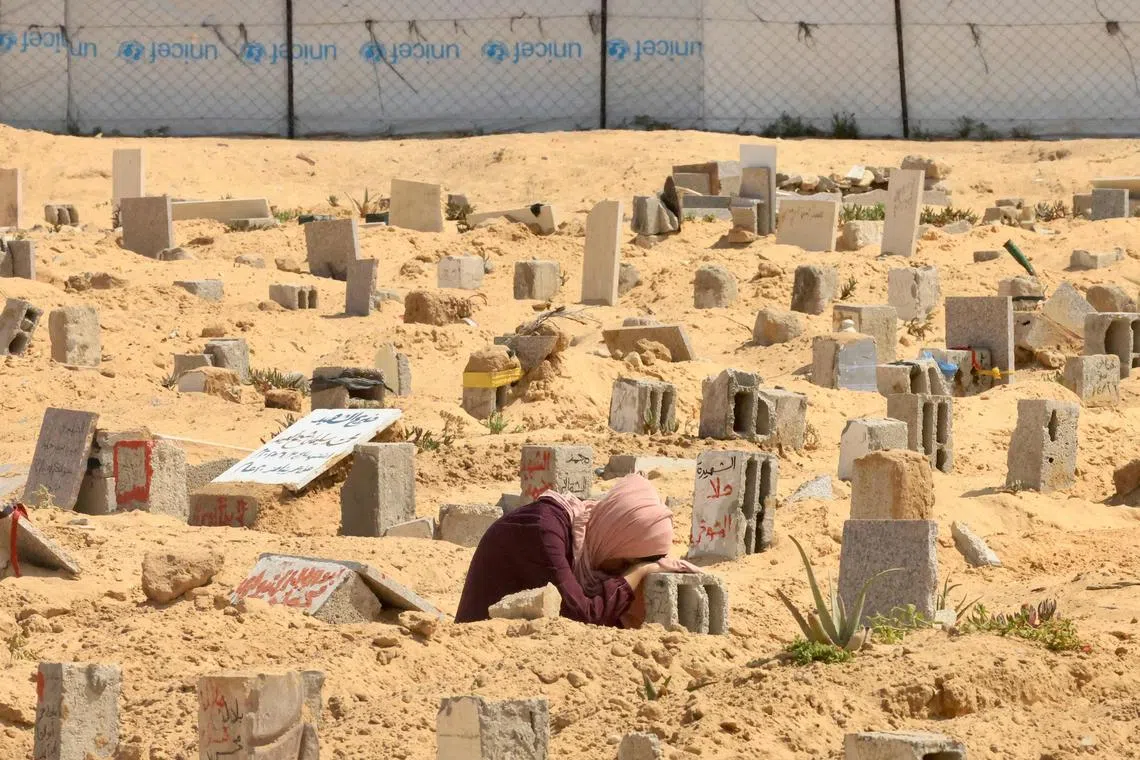50 killed in Gaza, many trying to reach food, as UN denounces Israeli-backed aid system
Sign up now: Get ST's newsletters delivered to your inbox

A Palestinian woman mourning at the grave of a relative in Khan Younis in the southern Gaza Strip on June 16.
PHOTO: AFP
Follow topic:
CAIRO/GAZA – Israeli fire killed at least 50 people, nearly half of them near an aid distribution site in Rafah operated by the US-backed Gaza Humanitarian Foundation (GHF) on June 16, the territory’s Health Ministry said, as UN officials denounced Israeli-backed aid delivery methods.
Medics said at least 23 of those people were killed and 200 others wounded near an aid distribution site in Rafah, in the latest in daily mass shootings that have killed hundreds of Palestinians
Israel has put the responsibility for distributing much of the aid it allows into Gaza in the hands of the GHF, a new group that operates three sites in areas guarded by Israeli troops.
The United Nations has rejected the plan, saying GHF distribution is inadequate and dangerous and violates humanitarian impartiality principles.
There was no immediate comment from the Israeli military about the June 16 reports of shootings.
In previous incidents, it has occasionally acknowledged troops opening fire near aid sites, while blaming militants for provoking the violence.
The GHF said in a statement late on June 16 that it has distributed more than 3 million meals at its four distribution sites without incident.
Relatives arrived at Nasser Hospital to mourn the dead. Women and children wept beside bodies wrapped in white shrouds.
“We went there thinking we would get aid to feed our children, but it turned out to be a trap, a killing. I advise everyone – don’t go there,” said Mr Ahmed Fayad, one of those who tried to reach aid on June 16.
‘Lethal distribution system’
Later on June 16, local health authorities said Israeli gunfire killed at least five people and wounded dozens of others as crowds of Palestinians gathered along the coastal road awaiting UN-funded aid trucks to enter the northern Gaza area.
Witnesses said dozens of desperate people looted four truckloads of food packages.
Mr Philippe Lazzarini, the head of the UN agency for Palestinian refugees, UNRWA, said in a post on X: “Scores of people have been killed and injured in the past days, including starving people trying to get some food from a lethal distribution system.”
Before the new system was set up, aid had been distributed to Gaza’s 2.3 million residents mainly by UN agencies, such as UNRWA, which employ thousands of staff inside Gaza and operate hundreds of sites across the breadth of the enclave.
Israel says it has had to crack down on distribution because Hamas fighters were diverting food aid.
Mr Lazzarini said Israel had not lifted restrictions on UN agencies bringing in aid, including UNRWA, despite an abundance of assistance ready to be moved into the enclave.
On June 15, Cogat, the Israeli military aid coordination agency, said that it had this week facilitated the entry of 292 trucks with humanitarian aid, including food and flour, from the UN and the international community into Gaza.
It said the Israeli military would continue to permit the entry of humanitarian aid while ensuring it did not reach Hamas.
Before the June 16 incident, the Health Ministry in Hamas-run Gaza said that at least 300 people had been killed so far, and more than 2,600 wounded, near aid distribution sites since the GHF began its operations.
On June 15, at least five people were killed as thousands of Palestinians approached two GHF distribution sites in the central and southern parts of the enclave.
The GHF said in a statement that it resumed food deliveries on June 15, distributing more than 2 million meals from its three distribution sites without incident.
The war in Gaza erupted 20 months ago after Hamas-led militants raided Israel and took 251 hostages and killed 1,200 people, most of them civilians, on Oct 7, 2023, Israel’s single deadliest day.
Israel’s military campaign since then has killed nearly 55,000 Palestinians, most of them civilians, according to health authorities in Gaza, and flattened much of the densely populated strip. Most of the population is displaced, and widespread malnutrition is a significant concern. REUTERS

